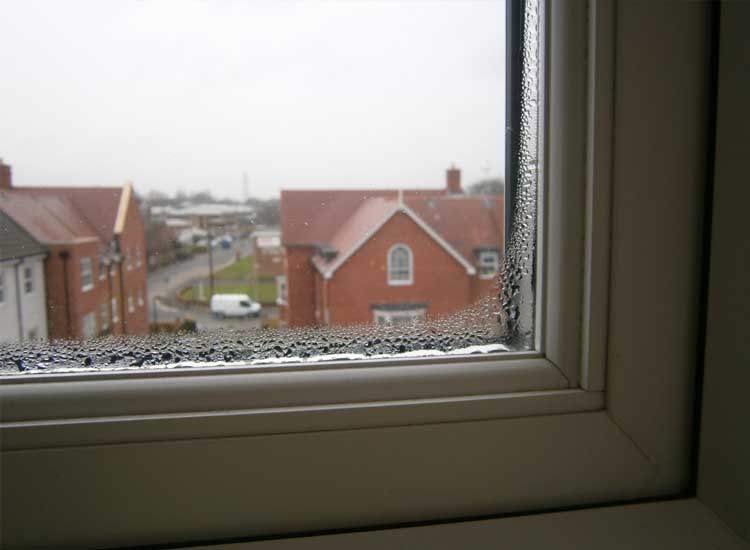What is Condensation?

Are you curious about what condensation is and what causes it? Essentially, it is when humid air meets a cold surface and forms water on the surface or in the fabric of your property.
Water vapour is present in air, however, the amount of water which air is capable of holding is dependant on the temperature of the air and the temperature of the surfaces the air meets. This moisture content of air is known as ‘relative humidity’. Warmer air can hold considerably more moisture than cooler air. As a result, as the air temperature rises the air can hold a much greater volume of moisture. This moisture can come from everyday activities such as cooking, washing or bathing. Even breathing creates moisture in the atmosphere without proper ventilation. This is why car windows steam up when you sit inside on a cold morning without the fan turned on and windows closed. You should look out for any condensation issues in your property. If condensation is left to develop, it can result in a musty smell and mould.
When the air has become saturated with moisture and meets a cold surface it will form water droplets on that surface. The temperature of the surface where this moisture condenses is known as the ‘dew point’.
Condensation on Windows
Condensation on windows is the most common form of condensation that any property owner will experience, however, this is less common now with the fitting of double or triple glazing. The warm moist air in the atmosphere meets the cold glass surface and condenses, leaving water droplets on the glass surface, the same applies to a cold wall or ceiling surface.
Condensation Signs
Condensation issues are most obvious during the colder winter months, which tends to be from October to April. The main cause for this is that many of us have our heating up full and do not open the windows in the colder months, thus resulting in a greater level of warm moist air being present in the atmosphere. Some of the most common forms of condensation are;
Water Gathering On Windows
Usually, the first sign of a condensation problem is water droplets gathering on windows. A small amount of this occasionally is normal, but consistent excess moisture on your windows can be a clear warning that your property has high moisture levels and ventilation issues.
Black Mould
A black mould often forms on walls affected by condensation, in many occasions this will form in corners of rooms in the form of a pyramid shape.
Peeling Plaster Or Paint
Condensation causing walls to become damp can impact plaster or wallpaper which is on the wall. This can result in wallpaper or paint peeling off the wall, making this room in your property less aesthetically pleasing.
Mould On Fabrics And Clothes
Fabrics which are affected by condensation are particularly likely to suffer from mould growth. The mould which consistently gathers on clothes or furniture will not necessarily be black.
Interstitial Condensation
Most condensation issues occur on the surface of walls and ceilings however the temperature which triggers the condensation known as the dew point may occur within the wall or voids in your property as well as the surface.
Condensation Solutions
Three simple steps should be taken to help control any condensation problems. This involves assessing the properties air moisture content (Relative Humidity), ventilation and insulation;
Controlling Humidity
Controlling the relative humidity within your property (Air moisture content) with the use of extractor fans in bathrooms and kitchens can help reduce your properties condensation issues. Closing the door to these rooms during or after cooking or bathing and allowing the extractor fan to work properly can prove very useful. Also reducing excess moisture by drying clothes outside or in a vented tumble dryer can significantly reduce the moisture in the air of your home. Note that using a dehumidifier will only slightly decrease your damp issue and will not tackle the source of the problem.
Providing Ventilation
Issues with inadequate ventilation in your property will allow moisture levels to increase in your home. Trickle vents within windows tend to work well, but if the issue is severe a long-term option may be to introduce mechanical ventilation. Positive input ventilation units can be installed in roof voids or within the property itself. The units draw air from outside or within the loft, pass the air through filters and if required heat to 10 degrees before introducing air back into your property through a ceiling or wall mounted vent. These PIV units push the moist contaminated air out of your property and reduces the relative humidity which stops the condensation.
Adding Insulation
Adding insulation to the internal face of an external wall can prevent a cold internal surface and therefore prevent warm air condensing on this surface. Also generally insulating your property can lift surface temperature and void temperature above the dew point and therefore stop condensation occurring.
What To Do Next?
If you are unsure of how to tackle condensation issues within your property, Richardson & Starling’s surveyors are experienced in identifying the source of condensation within properties and providing the most appropriate and cost-effective solution to a fresh air building.Not sure what is causing condensation in your home? Contact your local branch for advice or a property survey to regain your peace of mind.
